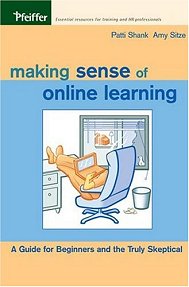Making Sense of Online Learning
By Murray Bourne, 26 Jun 2005
by Patti Shank, Amy Sitze

A Summary Review
A Guide for Beginners and the Truly Skeptical
Even though technology has radically changed the way the world works - and learns - there are still many luddites out there who refuse to accept that technology should be closely integrated into the design of learning.
How many lecturers are just waiting, looking foreward to the day when all this "e-learning" blows over and we can get back to the "real" stuff of lecturing...?
"Making Sense of Online Learning" encourages the reader to 'develop your own wisdom' (p.xiii) so that you will have some idea what to do when you are 'tasked with using technology to teach but don't understand what it all means or how it works' (p.xiv). This is a book which is more 'about' online learning than 'how-todo' online learning, but is valuable for anyone who needs to develop online courses.
It is refreshing that the authors...
- do not push online learning for the sake of it
- have learning at the core of their writing
- feel that online learning is not appropriate in all situations
- regard social interaction as important in online learning
- aim this book at beginners - they explain the basic jargon (like Learning Management Systems, Learning Objects, XML, metadata, etc) in an easy-to-follow glossary
Some questions that came to me:
- What is your understanding of online learning? Are we all on the same page with this?
- Do our students want online learning?
- Many of our students do not like online learning - why is this? Is this because online learning itself is a failure? Is it because they have not experienced well-designed online learning yet?
- How is 'hybrid' learning best achieved?
- Is dumping PPTs in Blackboard even worse than the 'electronic page turners' of not so long ago?
- How many lecturers have studied via online courses? If it was bad (and it often is), what can we do better?
- How much research is being done on the effectiveness of existing online materials?
Throughout the book, clearly labelled bottom line summaries are provided. Some gems are:
- ...the purpose of instruction is to provide opportunities for learning to occur (p.24)
- Multiple choice is not the way most of us deal with the world (p.26)
- What do people need to do with the content you want to teach? (p.28)
- Focus on usability (p.60)
The authors discuss the limitations of ADDIE, an instructional design model (p53):
A - analysis
D - design
D - development
I - implement
E - evaluate
The problem with ADDIE is that it may give you a 'technically correct' instructional design, but be so focussed on the content that the learning is ineffective.
The book concludes with a discussion on evaluating online courses. When was the last time you did this with your online offerings? There are 4 levels according to Kilpatrick (1994, quoted on p132):
- Reaction Did they like it?
- Learning Were the learning objectives achieved?
- Transfer Can learners apply the knowledge to the job?
- Results What is the impact of the new knowledge?
The paper-back "Making Sense of Online Learning" is recommended if you are not sure what you should be doing in the area of e-Learning.
Be the first to comment below.